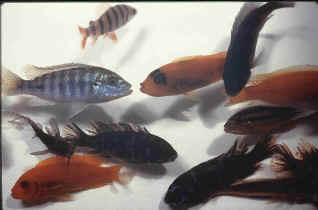|
|
Aquaria Information from |
|
|
|
Aquaria Information from |
|
| AFRICAN CICHLIDS |
|
A BACKGROUND ON CICHLIDS AND BASIC CARE TIPS |
|
African Cichlids offer a colorful choice to the aquarist who is looking for something different. The Pseudotropheus, Melanochromis, and most Haplochromis are now farm-raised in Florida and Taiwan. These fish are more tolerant of pH, and less susceptible to disease than their wild caught counterparts. Most types can be mixed, and there is no shortage of colors to choose from, many rivaling those of salt water fish. The best way to establish an African tank is to purchase the fish young and introduce them all at the same time. The ideal ratio is two females to each male. Africans should be kept crowded- that way the more rambunctious fish can spread their dominant behavior over a greater number of inhabitants. When new inhabitants are added, just rearrange the rocks and decorations so that new territories can be established. Once the fish have settled down, they can be fed. The combination of confusion and a full stomach will keep their minds off the new inhabitants. For the serious African Cichlid collector, there are always fish from Lake Tanganyika, and many other species of cichlids. No matter which you choose however, the following points are good to keep in mind: |

1) A long, rather than a high tank will provide more room for rockwork and caves. This allows the necessary territories and hiding places for intimidated fish. Long tanks also offer more surface area. 2) Good aeration and filtration should be provided. African Cichlids, like their South American cousins, have healthy appetites. Make sure your filtration is up to the bioload. 3) A good African Cichlid salt at the recommended amount on the package, and the use of dolomite as a substrate will duplicate the hard alkaline water conditions of the Rift Lakes. This is especially important for wild-caught specimens. 4) Temperature should be in the mid seventies. 5) Feed a varied diet of vegetables and meat types. A mixture of frozen foods is ideal.
|